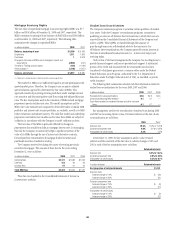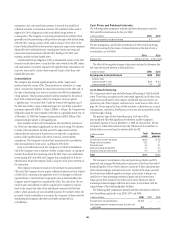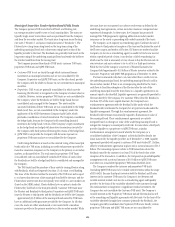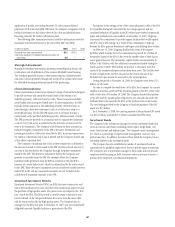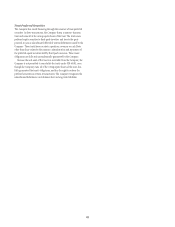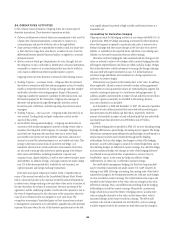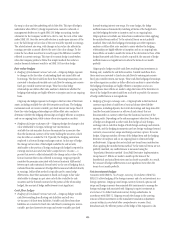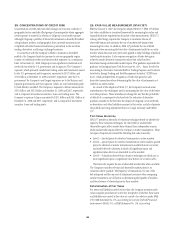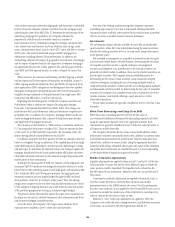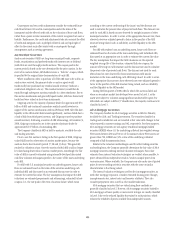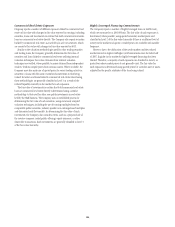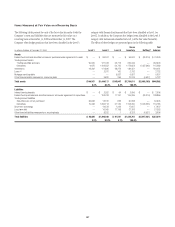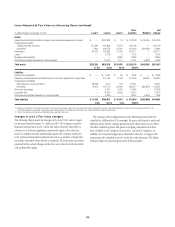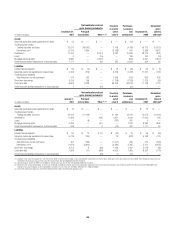Citibank 2008 Annual Report Download - page 196
Download and view the complete annual report
Please find page 196 of the 2008 Citibank annual report below. You can navigate through the pages in the report by either clicking on the pages listed below, or by using the keyword search tool below to find specific information within the annual report.the swap’s value and the underlying yield of the debt. This type of hedge is
undertaken when SFAS 133 hedge requirements cannot be achieved or
management decides not to apply SFAS 133 hedge accounting. Another
alternative for the Company would be to elect to carry the note at fair value
under SFAS 159. Once the irrevocable election is made upon issuance of the
note, the full change in fair value of the note would be reported in earnings.
The related interest rate swap, with changes in fair value also reflected in
earnings, provides a natural offset to the note’s fair value change. To the
extent the two offsets would not be exactly equal, the difference would be
reflected in current earnings. This type of economic hedge is undertaken
when the Company prefers to follow this simpler method that achieves
similar financial statement results to an SFAS 133 fair-value hedge.
Fair value hedges
•Hedging of benchmark interest rate risk—Citigroup hedges exposure
to changes in the fair value of outstanding fixed-rate issued debt and
borrowings. The fixed cash flows from those financing transactions are
converted to benchmark variable-rate cash flows by entering into receive-
fixed, pay-variable interest rate swaps. These fair-value hedge
relationships use dollar-offset ratio analysis to determine whether the
hedging relationships are highly effective at inception and on an ongoing
basis.
Citigroup also hedges exposure to changes in the fair value of fixed-rate
assets, including available-for-sale debt securities and loans. The hedging
instruments used are receive-variable, pay-fixed interest rate swaps. Most of
these fair-value hedging relationships use dollar-offset ratio analysis to
determine whether the hedging relationships are highly effective at inception
and on an ongoing basis, while certain others use regression analysis.
•Hedging of foreign exchange risk—Citigroup hedges the change in fair
value attributable to foreign-exchange rate movements in
available-for-sale securities that are denominated in currencies other
than the functional currency of the entity holding the securities, which
may be within or outside the U.S. Typically, the hedging instrument
employed is a forward foreign-exchange contract. In this type of hedge,
the change in fair value of the hedged available-for-sale security
attributable to the portion of foreign exchange risk hedged is reported in
earnings and not Accumulated other comprehensive income—a
process that serves to offset substantially the change in fair value of the
forward contract that is also reflected in earnings. Citigroup typically
considers the premium associated with forward contracts (differential
between spot and contractual forward rates) as the cost of hedging; this is
excluded from the assessment of hedge effectiveness and reflected directly
in earnings. Dollar-offset method is typically used to assess hedge
effectiveness. Since that assessment is based on changes in fair value
attributable to changes in spot rates on both the available-for-sale
securities and the forward contracts for the portion of the relationship
hedged, the amount of hedge ineffectiveness is not significant.
Cash flow hedges
•Hedging of benchmark interest rate risk—Citigroup hedges variable
cash flows resulting from floating-rate liabilities and roll over
(re-issuance) of short-term liabilities. Variable cash flows from those
liabilities are converted to fixed-rate cash flows by entering into receive-
variable, pay-fixed interest-rate swaps and receive-variable, pay-fixed
forward-starting interest-rate swaps. For some hedges, the hedge
ineffectiveness is eliminated by matching all terms of the hedged item
and the hedging derivative at inception and on an ongoing basis.
Citigroup does not exclude any terms from consideration when applying
the matched terms method. To the extent all terms are not perfectly
matched, these cash-flow hedging relationships use either regression
analysis or dollar-offset ratio analysis to assess whether the hedging
relationships are highly effective at inception and on an ongoing basis.
Since efforts are made to match the terms of the derivatives to those of the
hedged forecasted cash flows as closely as possible, the amount of hedge
ineffectiveness is not significant even when the terms do not match
perfectly.
Citigroup also hedges variable cash flows resulting from investments in
floating-rate, available-for-sale debt securities. Variable cash flows from
those assets are converted to fixed-rate cash flows by entering into receive-
fixed, pay-variable interest-rate swaps. These cash-flow hedging relationships
use either regression analysis or dollar-offset ratio analysis to assess whether
the hedging relationships are highly effective at inception and on an
ongoing basis. Since efforts are made to align the terms of the derivatives to
those of the hedged forecasted cash flows as closely as possible, the amount
of hedge ineffectiveness is not significant.
•Hedging of foreign exchange risk—Citigroup locks in the functional
currency equivalent of cash flows of various balance sheet liability
exposures, including deposits, short-term borrowings and long-term debt
(and the forecasted issuances or rollover of such items) that are
denominated in a currency other than the functional currency of the
issuing entity. Depending on the risk-management objectives, these types
of hedges are designated as either cash-flow hedges of only foreign-
exchange risk or cash-flow hedges of both foreign-exchange and interest-
rate risk, and the hedging instruments used are foreign-exchange forward
contracts, cross-currency swaps and foreign-currency options. For some
hedges, Citigroup matches all terms of the hedged item and the hedging
derivative at inception and on an ongoing basis to eliminate hedge
ineffectiveness. Citigroup does not exclude any terms from consideration
when applying the matched terms method. To the extent all terms are not
perfectly matched, any ineffectiveness is measured using the
“hypothetical derivative method” from FASB Derivative Implementation
Group Issue G7. Efforts are made to match up the terms of the
hypothetical and actual derivatives used as closely as possible. As a result,
the amount of hedge ineffectiveness is not significant even when the
terms do not match perfectly.
Net investment hedges
Consistent with SFAS No. 52, Foreign Currency Translation (SFAS 52),
SFAS 133 allows hedging of the foreign-currency risk of a net investment in a
foreign operation. Citigroup uses foreign-currency forwards, options and
swaps and foreign-currency-denominated debt instruments to manage the
foreign-exchange risk associated with Citigroup’s equity investments in
several non-U.S. dollar functional currency foreign subsidiaries. In
accordance with SFAS 52, Citigroup records the change in the carrying
amount of these investments in the cumulative translation adjustment
account within Accumulated other comprehensive income (loss).
Simultaneously, the effective portion of the hedge of this exposure is also
190




